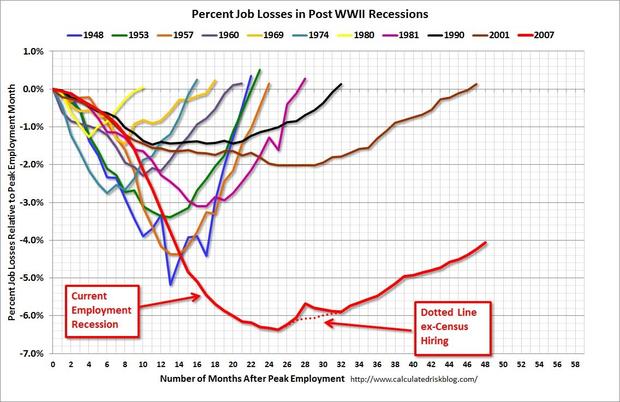February jobs: Another robust report
(MoneyWatch) One month is a fluke, two months is encouraging, but three months makes a trend. The February jobs report showed 227,000 jobs were created in February and the previous two months were revised higher by 61,000. The unemployment rate remained at 8.3 percent, after falling for five consecutive months.
The jobless rate has remained above 8 percent for three years, the longest stretch since monthly records began in 1948. But the flat rate should actually be considered one of the bright spots of the report and there's a convoluted explanation of why that is the case.
One reason why unemployment has dropped since last year is that many out-of-work people got so disgruntled, they stopped looking for jobs. The government only counts you as unemployed if you are actively looking for a job. In econo-speak, this is referred to as the "participation rate" and it is the percentage of the working age population in the labor force. Over the last 20 years, it has been around 66-67 percent and it was 66 percent before the economy entered recession in December 2007.
Economy adds 227K jobs, jobless rate unchanged
Last month, the participation rate rose to 63.9 percent, a slight increase from 63.7 percent in January, which was the lowest participation rate since the early 1980s. While some of the decline in the labor force is due to demographics (as boomers near retirement age, the participation rate has naturally slid by one percent), economists say that a sustained rise in the number of people looking for jobs would be a good sign, even if it pushed up the unemployment rate in the short-term.
The bottom line in February: Despite an increase in the number of people looking for jobs during the month, the rate stayed at 8.3 percent and that is a positive.
So how is this jobs recovery going overall? Since employment bottomed in February 2010, the economy has added just under 3.5 million jobs. However, there are still 5.3 million fewer total jobs now than when the recession started.
Like the overall economy, progress is good, but we have a long way to go. At the current rate of job creation, it will take approximately four years to return to the pre-recession level of 5 percent. (You can check out this nifty jobs calculator from the Atlanta Fed to see how many jobs are needed to lower the unemployment rate to some target over a certain period.)
Some more sobering facts:
-- Of the 12.8 million Americans currently unemployed, 5.4 million have been unemployed for six months or more, 42.6 percent of the total unemployed. The average duration of unemployment stands at 40.1 weeks.
-- It's still hard to land a job due to competition. There are currently approximately 4 unemployed people for every job opening available and the number of job openings remains below the level when the recession began in December 2007.
-- According to a recent study, just 7 percent of those who were let go during the recession have matched their previous income. A little over half reported taking a pay cut - and of those, 29 percent took a reduction in salary by 30 percent or higher. To top off the bad news, 30 percent of the reemployed took a reduction in benefits.
-- Cuts to state and local government workforces have been particularly damaging for women. Of the net change in total state and local employment between 2007 and 2011, 70 percent of the drop is from female employees. Today, there are about 540,000 fewer women in state and local jobs than in 2007.
-- Recent college graduates have had a hard time landing jobs and those that have jobs, are earning less. The Economic Policy Institute found that the average inflation-adjusted hourly wage for male college graduates aged 23 to 29 dropped 11 percent over the past decade. For female college graduates of the same age, the average wage is down 7.6 percent.
-- Wages are not likely to rise enough to make up for the drubbing Americans took during the Great Recession. According to the Federal Reserve Q4 2011 Flow of Funds report, household net worth peaked at $66.8 trillion in Q2 2007, then plunged $50.4 trillion in Q1 2009 and stood at $58.5 trillion in Q4 2011. So we're about half-way there: up $8.0 trillion from the bottom, but still $8.4 trillion below the peak.
February Jobs Report
-- Jobs Created: +227,000 (January and December revised up by 61,000)
-- Private Sector Jobs Created: +233,000
-- Government: -6,000 (in 2011, government lost an average of 22,000 per month)
-- Unemployment Rate: 8.3 percent
-- Under-Employment Rate (marginally-attached, part-time): 14.9 percent (the first time its been below 15 percent since January 2009-in 2007, the rate was 8 percent)
-- Total Number of Unemployed: 12.8 million (unchanged)
-- Long-term unemployed (jobless for 27 weeks and over): 5.4 million representing 42.6 percent of the total unemployed (down from 5.5 million)
-- Average duration of unemployment: 40 weeks (from 40.1 weeks)
-- Average workweek: 34.5 (unchanged)
-- Average Hourly Earnings: up $0.03 to $23.31 (up 1.9 percent over past 12 months)

